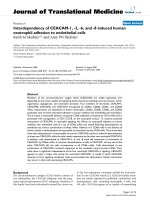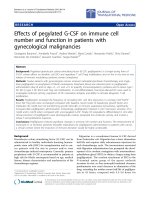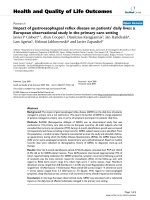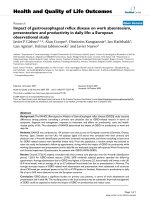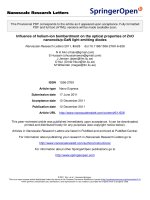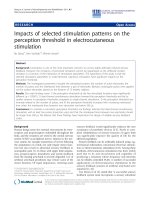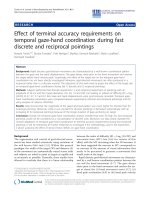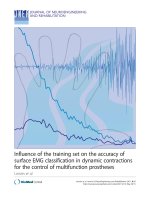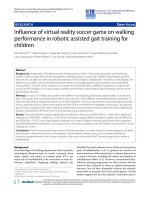báo cáo hóa học: " Influence of passive leg movements on blood circulation on the tilt table in healthy adults" pdf
Bạn đang xem bản rút gọn của tài liệu. Xem và tải ngay bản đầy đủ của tài liệu tại đây (1.39 MB, 13 trang )
Journal of NeuroEngineering and
Rehabilitation
BioMed Central
Open Access
Research
Influence of passive leg movements on blood circulation on the tilt
table in healthy adults
David Czell*1, Reinhard Schreier1, Rüdiger Rupp2, Stephen Eberhard1,
Gery Colombo1,3 and Volker Dietz1
Address: 1Spinal Cord Injury Center, Balgrist University Hospital, Zurich, Switzerland, 2Orthopaedic Hospital of Heidelberg University,
Department II, Heidelberg, Germany and 3Hocoma AG, Medical engineering, Volketswil, Switzerland
Email: David Czell* - ; Reinhard Schreier - ; Rüdiger Rupp - ;
Stephen Eberhard - ; Gery Colombo - ; Volker Dietz -
* Corresponding author
Published: 25 October 2004
Journal of NeuroEngineering and Rehabilitation 2004, 1:4
doi:10.1186/1743-0003-1-4
Received: 30 August 2004
Accepted: 25 October 2004
This article is available from: />© 2004 Czell et al; licensee BioMed Central Ltd.
This is an open-access article distributed under the terms of the Creative Commons Attribution License ( />which permits unrestricted use, distribution, and reproduction in any medium, provided the original work is properly cited.
tilt steppertilt tableblood circulationsyncopenear-syncopevertical mobilization
Abstract
Background: One problem in the mobilization of patients with neurological diseases, such as spinal cord
injury, is the circulatory collapse that occurs while changing from supine to vertical position because of the
missing venous pump due to paralyzed leg muscles. Therefore, a tilt table with integrated stepping device
(tilt stepper) was developed, which allows passive stepping movements for performing locomotion training
in an early state of rehabilitation. The aim of this pilot study was to investigate if passive stepping and cycling
movements of the legs during tilt table training could stabilize blood circulation and prevent neurallymediated syncope in healthy young adults.
Methods: In the first experiment, healthy subjects were tested on a traditional tilt table. Subjects who
had a syncope or near-syncope in this condition underwent a second trial on the tilt stepper. In the second
experiment, a group of healthy subjects was investigated on a traditional tilt table, the second group on
the tilt ergometer, a device that allows cycling movements during tilt table training. We used the chi-square
test to compare the occurrence of near-syncope/syncope in both groups (tilt table/tilt stepper and tilt
table/tilt ergometer) and ANOVA to compare the blood pressure and heart rate between the groups at
the four time intervals (supine, at 2 minutes, at 6 minutes and end of head-up tilt).
Results: Separate chi-square tests performed for each experiment showed significant differences in the
occurrence of near syncope or syncope based on the device used. Comparison of the two groups (tilt
stepper/ tilt table) in experiment one (ANOVA) showed that blood pressure was significantly higher at the
end of head-up tilt on the tilt stepper and on the tilt table there was a greater increase in heart rate (2
minutes after head-up tilt). Comparison of the two groups (tilt ergometer/tilt table) in experiment 2
(ANOVA) showed that blood pressure was significantly higher on the tilt ergometer at the end of headup tilt and on the tilt table the increase in heart rate was significantly larger (at 6 min and end of head-up
tilt).
Conclusions: Stabilization of blood circulation and prevention of benign syncope can be achieved by
passive leg movement during a tilt table test in healthy adults.
Page 1 of 13
(page number not for citation purposes)
Journal of NeuroEngineering and Rehabilitation 2004, 1:4
Background
Several studies have confirmed that lack of movement
leads quickly to profound negative physiological and biochemical changes in all organs and systems of the body [15]. It is important for patients suffering from diseases such
as stroke, spinal cord and traumatic brain injury to be
mobilized at an early state of rehabilitation [6]. As these
patients are bedridden, their lower limbs are mainly
mobilized through manual therapy or with cycling
ergometers. Patients with spinal cord injuries are disposed
to the occurrence of circulatory collapse when changing
from a horizontal to a vertical position because of the lack
of sympathetic activity and the missing contractions of leg
muscles in the lower extremities that normally act as muscle pumps [7,8]. This instability of the circulatory system
occurs at an early stage of rehabilitation and leads to
delayed functional training of these patients. In a chronic
phase, an overactivity of the spinal sympathetic system
could take place, which can lead to vasoconstriction and
hypertension [9].
Head-up tilt table testing has been used for over 50 years
by physiologists and physicians for many purposes. This
includes the study of the human body's heart rate and
blood pressure adaptations to changes in position, for
modeling responses to hemorrhage, as a technique for
evaluating of orthostatic hypotension, as a method to
study hemodynamic and neuroendocrine responses in
congestive heart failure, autonomic dysfunction and
hypertension, as well as a tool for drug research [7,10-14].
It also has become a useful device in the mobilization of
spinal cord and traumatic brain injured patients, as well as
in patients suffering from stroke [15]. The key feature of a
tilt table is the continuously adjustable position of a
patient from horizontal to vertical. This represents an
orthostatic challenge, because blood pools in the lower
extremities, with the danger that in susceptible individuals vasovagal syncope could occur within approximately
20 minutes. The afferent end of this reflex pathway may be
mediated by left ventricular or right atrium mechanoreceptors that are activated during vigorous contraction
around under-filled chambers, in a situation similar to
severe hemorrhage. Information from these mechanoreceptors travels along vagal afferent C fibers to the brainstem, which mediates the efferent response consisting of
withdrawal of sympathetic vasomotor tone and by the
vagal system [16,17].
In addition to the traditional tilt table, a novel apparatus
with stepping device (tilt stepper) was developed in 1998
at the research department of the Paraplegia Centre of the
Balgrist University Hospital in Zurich, Switzerland in collaboration with the Department Orthopaedic II of the
Orthopaedic Hospital of Heidelberg to enable a mobiliza-
/>
tion with stabilized circulation and to begin with a locomotion training in an early state of rehabilitation.
In the tilt stepper, the patient is strapped by a safety belt
to the tilt table while the legs are moved passively in a
physiological stepping pattern (Figure 1). The inclination
can be continuously adjusted from a horizontal to a vertical position. The distribution of the blood correlates
directly to the sinus of the angle of inclination. Between
30 and 60 degrees this angle is linear [18]. For inclines
larger than 60 degrees, there is a plateau of hemodynamic
effects. For the present study, we choose an angle of 75
degrees because in previous studies it has been shown that
syncope was more likely to occur at an angle over 60
degrees [18]. To investigate if there is a difference between
passive stepping and passive cycling leg movements, we
also used a tilt table with an ergometer device (tilt ergometer, Figure 3).
There are only a few studies that have investigated how
passive movement of the legs during a tilt table treatment
affects circulation. In these studies, either functional electrical stimulation of the leg muscles [19-21] was used, or
patients were placed in sitting positions on a cycle ergometer [22]. The results of these studies suggest that passive
movements of the legs could stabilize blood circulation.
There have also been studies which have utilized a tilt
table with passively moving legs. However, in these studies only patients with recurrent vasovagal syncopes were
enrolled, the syncope was pharmacologically provoked
[5,23-30].
The aim of our experiments was to investigate if passive
stepping and cycling movements of the legs during a tilt
table test can stabilize blood circulation and prevent neurally mediated syncope in healthy young adults.
Methods
Participants
With the permission from the local Ethics Committee and
the informed consent of the volunteers, the response of
the blood circulation was analyzed in healthy subjects.
The exclusion criteria included: recurrent syncope or nearsyncope in clinical history, regular medication, abuse of
nicotine or alcohol, cardiovascular or neurological diseases, acute or chronic infections, psychiatric disorder and
body mass index <18 or >25. All subjects underwent a
physical investigation and an ECG was completed one
week before the experiment.
In the first experiment, we examined 12 healthy young
adults (age 24 ± 5 years) on a traditional tilt table. The
subjects, who had syncope or near-syncope were treated
on the tilt stepper after a waiting period of 4 weeks. Syncope was defined as a transient loss of consciousness
Page 2 of 13
(page number not for citation purposes)
Journal of NeuroEngineering and Rehabilitation 2004, 1:4
/>
Figure 1
The tilt table with stepping device (tilt stepper)
The tilt table with stepping device (tilt stepper)
associated with a loss of postural tone. Near-syncope was
defined as the appearance of pallor, nausea, light-headedness, diaphoresis or blurred vision. Both conditions were
associated with the following hemodynamic changes: a
decrease in systolic blood pressure > 60% from baseline
values or an absolute value < 80 mmHg (vasodepressor
response) and/or a decrease in heart rate > 30 % form the
baseline value or an absolute value < 40 beats/min (cardio-inhibitory response) [31].
In the second experiment, we enrolled 42 healthy subjects
(age 27 ± 4 years). They were randomized into two
Page 3 of 13
(page number not for citation purposes)
Journal of NeuroEngineering and Rehabilitation 2004, 1:4
/>
Figure 3
The tilt table with ergometer device (tilt ergometer)
The tilt table with ergometer device (tilt ergometer)
groups: group I (23 subjects) was put on a traditional tilt
table, while the Group II (19 subjects) on a tilt ergometer.
The age of the subjects was restricted to below 35 years,
because the cardiovascular response is strongly dependent
on age [32].
Procedures
The aim of the first experiment was to investigate if the
blood circulation could be stabilized in people who have
a disposition for an "early" appearance of a neurallymediated syncope on a traditional tilt table. The
Page 4 of 13
(page number not for citation purposes)
Journal of NeuroEngineering and Rehabilitation 2004, 1:4
appearance of a neurally-mediated syncope is physiological and it may occur in all subjects. The interpersonal difference lies in the duration that the subject can be in
standing posture until syncope or near-syncope occurs. A
decrease of the systolic blood pressure up to maximal 15
mmHg and/or an increase in heart rate up to 20 bpm during the first 6 minutes are considered as a normal reaction
to compensate the change in the position of the body
[31].
The blood pressure was non-invasively measured with a
tonometric blood pressure device. Subjects who suffered a
syncope or near-syncope during the first session on the
traditional tilt table were in the second session treated on
the tilt stepper. In the second experiment, we investigated
the effect of passively induced movements on circulation
by a cycle ergometer on a tilt table. We enrolled 42 subjects: 23 on a traditional tilt table and 19 on the tilt
ergometer.
/>
In both experiments, after 15 minutes of rest the subjects
were tilted head-upright at a 75° angle and were returned
to the supine position if a syncope or near-syncope
occurred or after completion at 30 minutes. Heart rate and
blood pressure were measured continuously and noninvasively. Head-up tilt tests were performed in the morning in a dim room. All subjects were instructed to fast
overnight and relax the muscles of their lower limbs during the trials. This was monitored with an EMG-measurement on legs (Mm. biceps femoris, rectus femoris,
gastrocnemii, tibialis ant.), randomly tested in the first
experiment and regularly tested during the second experiment. The EMG signals were amplified and transferred to
a personal computer. They were recorded by a data acquisition tool (SolEasy by Aleasolution GmbH, Zurich, CH).
Tilt table with stepping device (Tilt stepper)
The tilt stepper is a traditional tilt table (Gymna, Belgium)
combined with an integrated leg drive that allows a passive movement of the lower extremities (Figures 1 and 2)
Figure 2
The tilt stepper: generation of leg movements
The tilt stepper: generation of leg movements
Page 5 of 13
(page number not for citation purposes)
Journal of NeuroEngineering and Rehabilitation 2004, 1:4
The leg drive that is connected to the thigh by a cuff
induces a hip flexion or extension movement. As the feet
of the patient are fixed to footplates, the knee is also flexed
or extended, respectively. In those phases where the hip
and knee joints are extended, the leg pushes down a
spring-dampened footplate, which is then again pushed
against a foot spring that is mounted within these plates.
This footplate generates a loading force on the foot sole of
the patient during extension. Applying this cycle of flexion
and extension in an alternating way leads to physiological
kinetics of the generated motion. A special mechanism is
mounted under the hip joint and allows for adjustment of
hip extension up to 20°.
Depending on the blood circulation condition of the
patient, the device can be tilted to different angles up to a
vertical position. This makes it possible for the patient to
become accustomed, step-by-step, to the upright position
in combination with passive leg movements. The speed of
the alternating stepping movements and the range of
motion of hip/knee joints can be adjusted by a control
panel. The basic construction consists of a linear drive
(Parker-Hannifin, Germany), with a precision ball screw
that is driven by a synchronous motor via toothed belt
(maximum speed 450 mm/sec, maximum force 1400 N,
maximum torque of 400 Nm at the hip joint). The movement frequencies range from 0.2 to 0.5 Hz (i.e. one cycle
of flexion and extension takes between 2 and 5 sec).
To secure subjects on the tilt table during experiments, fixation with a special harness was used during all experiments (Figure 1).
The tilt table with ergometer (Tilt ergometer)
The tilt ergometer consists of a traditional tilt table with
an additional ergometer device (Tera Joy Germany) that
allows a passive cycling movement of the lower extremities. From a technical point of view, the tilt ergometer
construction is simpler than the tilt stepper, but it gener-
/>
ates a non-physiological motion concerning gait phase
related forces on the foot sole. The cycle frequency was
between 0.2–0.5 Hz.
Recordings and Measurement
Blood pressure was measured continuously and non-invasively by a Colin CBM-7000 (Hayashi, Komaki City,
Japan). The Colin CBM – 7000 is a tonometric blood pressure device that allows measuring beat-to-beat blood pressure (systolic, mean, diastolic), continuous arterial blood
pressure waveform, beat-to-beat and continuous
electrocardiography.
Statistical analysis
In both experiments we used the chi-square test to compare the occurrence of near-syncope/syncope in both
groups (tilt table/tilt stepper and tilt table/tilt ergometer).
We performed 2 by 4 repeated measures ANOVAs with 2
between factors (device group – namely tilt table vs. tilt
stepper or tilt table vs. tilt ergometer), 4 within factors
(time – supine, 2 minutes, 6 minutes and end of head-up
tilt) and in their interaction (groups × time) for blood
pressure and heart rate. Pairwise comparisons were made
with the t-test with additional Bonferroni's correction.
Results
In the first experiment, 7 of 12 subjects (58%) had a syncope or near-syncope on the traditional tilt table. There
was an obvious increase in heart rate in the first 6 minutes
after changing the position from supine to upright. None
of these 7 subjects had a syncope or near-syncope during
the treatment session on the tilt stepper 4 weeks later.
Comparing the occurrence of near syncope/syncope in
both sessions with the chi-square test, there was a significant difference ((χ2 (1.1) = 6.465, p = 0.011). Table 1 gives
a short overview of these results. The same subjects, who
collapsed on the traditional tilt table, did not have syncope or near-syncope while treated on the tilt stepper.
Table 1: Occurrence of near-syncope and syncope in experiment one (tilt stepper)
no syncope
traditional tilt table [n = 12]
tilt stepper [n = 7]
near-syncope
syncope
5 (42%)
7 (100%)
5 (42%)
0 (0%)
2 (18%)
0 (0%)
In the ANOVA for repeated measures there were no significant differences for blood pressure within each group
(time 4 levels: supine, 2, 6 and end of head-up tilt; F (1,6)
= 4.66, p < 0.0743), but there were significant differences
between groups (two levels: tilt stepper and tilt table; F
(3,33) = 6.33, p < 0.0016)) and in the interactions
(F(3,18) = 7.24, p < 0.0022). The blood pressure differs
between the two treatments at the end of head – up tilt (p
< 0.0029), but not at 2 minutes (p < 1.000) and at 6 minutes (p < 1.000) (Pairwise comparisons with the t-test and
additional Bonferroni's correction). However, there could
be shown a trend for a higher blood pressure at 2 minutes
Page 6 of 13
(page number not for citation purposes)
Journal of NeuroEngineering and Rehabilitation 2004, 1:4
/>
and at 6 minutes after head-up tilt in the group treated in
the tilt stepper.
no significant differences at 6 minutes (p < 0.2051) and at
the end of head-up tilt (p < 1.000).
There were significant differences for heart rate within
each group (time 4 levels: supine, 2, 6 and end of head-up
tilt; F (1, 6) = 12.17, p < 0.0130) between groups (two levels; F (3, 33) = 21.16, p < 0.0001) and in the interactions
(F (3, 18) = 8.68, p < 0.0009). For the group treated on the
traditional tilt table, pairwise comparisons with the t-test
with additional Bonferroni's correction showed a significantly higher heart rate at 2 minutes (p < 0.0.0060), but
In the second experiment, 13 of 23 subjects (57 %) who
were on the traditional tilt table had syncope (3) or nearsyncope (10). None of the 19 subjects who were on the tilt
ergometer had syncope but 4 subjects had near-syncope
(21%). Comparing the occurrence of near syncope/syncope in both sessions with the chi-square test (χ2 (1.1) =
5.443) there was a significant difference (p = 0.021)
(Table 2).
Table 2: Mean blood pressure and heart Rate +/- SE during 75° head-up tilt on the tilt-stepper
during supine position
mean blood pressure
[mmHg]
traditional tilt table [n =
12]
tilt stepper [n = 7]
heart rate [beats/min]
traditional tilt table [n =
12]
tilt stepper [n = 7]
2-min after head-up tilt
6-min after head up tilt
end of head-up tilt
90 +/- 4
95 +/- 4
94 +/- 4
80 +/- 3*
89 +/- 4
93 +/- 5
97 +/- 2
95 +/- 6*
65 +/- 5
80 +/- 5*
78 +/- 4
65 +/- 5
61 +/- 3
69 +/- 3*
71 +/- 3
71 +/- 5
* p < 0.05 (compared with ANOVA for repeated measures)
In the ANOVA for repeated measures, there were significant differences for blood pressure within each group
(time 4 levels: supine, 2, 6 and end of head-up tilt; F (1,6)
= 34.43, p < 0.0001) between groups (two levels; F (3,33)
= 13.42, p < 0.0001)) and in the interactions (F(3,18) =
10.95, p < 0.0001). Pairwise comparisons with the t-test
(additional Bonferroni's correction) showed no significant differences at 2 minutes (p < 0.5221) and at 6 minutes (p < 0.4429) but a significant difference at the end of
head – up tilt (p < 0.0001). However, there could be
shown a trend for a higher blood pressure at 2 minutes
and at 6 minutes after head-up tilt in the group treated on
the tilt ergometer. There were significant differences for
heart rate within each group (time 4 levels: supine, 2, 6
and end of head-up tilt; F (1,6) = 12.17, p < 0.0130),
between groups (two levels; F (3,33) = 21.16, p < 0.0001),
and in the interactions (F(3,18) = 8.68, p < 0.0009). Pairwise comparisons with the t-test (additional Bonferroni's
correction) showed no significant differences at 2 minutes
(p < 0.3317), but a significantly higher heart rate in the
group treated on the tilt table at 6 minutes (p < 0.0007)
and at the end of head – up tilt (p < 0.0002).
All subjects on the tilt stepper and tilt ergometer completed 30 minutes of head-up tilt. The duration of the
head-up tilt was different in the group on the traditional
tilt table, as an abrupt decrease of blood pressure or symptoms of near-syncope occurred.
In the head-up tilt position the subject stands on the footplates on the tilt stepper, whereas in the tilt ergometer the
harness holds the whole body weight. The subjects who
were investigated on the tilt stepper felt comfortable during the whole experiment, whereas the subjects examined
on the tilt ergometer in experiment two complained of
discomfort. The subjects on the tilt ergometer experienced
more discomfort because of the perception of no lower
limb support. These statements were subjective; no standardized assessment instrument was used to measure the
comfort.
Tables 3 and 4 and Figures 4 and 5 provide an overview
about the response of the blood pressure of subjects tested
on the traditional tilt table (with and without syncope, n
= 12 in experiment one and n = 23 in experiment two) and
subjects with passive leg movements during the tilt table
test on the tilt stepper (n = 7) and tilt ergometer n = 19).
In Figures 6 and 7, recordings illustrating the development of systolic and diastolic blood pressure and heart
rate for one subject with syncope (Figure 6) and another
subject without syncope (Figure 7) during the tilt table
Page 7 of 13
(page number not for citation purposes)
Journal of NeuroEngineering and Rehabilitation 2004, 1:4
/>
Table 3: Occurrence of near-syncope and syncope in experiment two (tilt ergometer)
no syncope
near-syncope
10 (43%)
15 (79%)
traditional tilt table [n = 23]
tilt ergometer [n = 19]
syncope
3(14%)
0 (0%)
10 (43%)
4 (21%)
Table 4: Mean blood pressure and heart rate +/- SE during 75° head-up tilt on the tilt ergometer
during supine position
2-min after head-up tilt
6-min after head-up tilt
end of head-up tilt
traditional tilt table [n =
23]
tilt ergometer [n = 19]
heart rate [beats/min]
92 +/- 4
92 +/- 6
90 +/- 5
80 +/- 4*
91 +/- 5
96 +/- 3
95 +/- 2
93 +/- 4*
traditional tilt table [n =
23]
tilt ergometer [n = 19]
64 +/- 5
79 +/- 5
82 +/- 3*
78 +/- 5*
65 +/- 3
74 +/- 4
73 +/- 5*
68 +/- 4*
mean blood pressure
[mmHg]
* p < 0.05 (compared with ANOVA for repeated measures)
test are shown. The observed progression of blood
pressure and heart rate of the subject who had syncope is
typical for a neurally-mediated syncope, because of the
sudden decrease of systolic and diastolic blood pressure
combined with bradycardia more than 20 minutes after
head-up tilt. Also typical is the increase in heart rate
observed in the first 6 minutes after head-up tilt. All subjects treated on the tilt table had this benign form of syncope and showed a similar blood pressure and heart rate
progression during the tilt table test.
Figure 7 is a good example for the normal progression of
blood pressure and heart rate during a tilt table test. 2
minutes after head-up tilt there is a slight decrease of
systolic and diastolic blood pressure and a slight increase
of heart rate, a physiological mechanism of compensation
for the change of position (supine to head-up tilt).
Figure 8 is an example for the EMG activity in the right leg
during the tilt stepper test, and Figure 9 during the tilt
table test. It becomes obvious that there is no active
muscle activity. The ups and downs in the curve of the
muscle gastrocnemius on the tilt stepper are from the passive movements.
Discussion
proven useful for circulatory training of patients suffering
from several neurological diseases. However, the treatment is limited by the occurrence of circulatory collapse
[16]. Both hypotension and bradicardia leading to syncope during tilt tests are also common events in healthy
persons. These responses are considered to be part of a
reflex response triggered by a sympathetic-induced hypercontraction of an almost empty left ventricular chamber
[34]. In both experiments there were no recurrent syncope
or near-syncope in the clinical history of the subjects and
the ECG did not show any abnormities. For these reasons,
and because of the development of the heart rate and
blood pressure in our experiments, the occurring syncopes
and near-syncopes that occurred ought to be benign and
so called neurally-mediated syncopes or vasovagal syncopes. It is a physiological form of syncope that can occur in
healthy persons. Some persons have the disposition of
suffering a neurally-mediated syncope earlier than others
[35]. This benign form of syncope can be differentiated
from malignant syncopes, like the hyperadrenergic orthostatic hypotension (decrease of blood pressure and
increase of heart rate), hypoadrenergic orthostatic
hypotension (decrease of blood pressure without an
increase of heart rate) and postural tachycardia syndrome
(massive increase of heart rate without decrease in blood
pressure) by recording heart rate and blood pressure [31].
The tilt table is an apparatus that has become an important part in the evaluation of patients with unexplained
syncope or loss of consciousness [14,24,33]. It has also
Page 8 of 13
(page number not for citation purposes)
Journal of NeuroEngineering and Rehabilitation 2004, 1:4
/>
Figure 4
Blood pressure +/- SE during 75° the tilt table and tilt stepper test
Blood pressure +/- SE during 75° the tilt table and tilt stepper test
Although the tilt table has become an accepted diagnostic
tool, there are no comparable studies with the tilt table in
which the effect of passive leg motion on circulation have
been investigated.
The aim of these two experiments was to investigate if passive leg movements during head-up tilt can prevent syncope. The data in the present study show a stabilizing
effect on the blood circulation and this study suggests that
there is an effect on preventing neurally-mediated syncope by both devices. In the first experiment, none of the
subjects who had syncope/near-syncope on the traditional tilt table had syncope/near-syncope four weeks
later on the tilt stepper. In the second experiment, only 4
subjects who were treated on the tilt ergometer had nearsyncope. In both experiments the increase of heart rate
was larger in the group tested on the traditional tilt table.
A correlation between heart rate and appearance of syncope was described [16,36]. An increase in heart rate > 18
bpm during the first minutes after changing position from
supine to upright leads to syncope, with a sensitivity of
90% and a specification of 100%. Consequently, the positive effect of passive leg movement on heart rate is obvious. Heart rate and blood pressure give an indication of
the sympathetic activity, which is activated on the tilt table
[37,38]. This increased sympathetic activity stimulates
mechano-receptors in the ventricle, which leads to an activation of the vagus nerve and a reflexive decrease of sympathetic activity. The vagus activity leads to bradycardia
and vasodilatation: the Bezold-Jarisch-Reflex [36]. We
suggest that the sympathetic activity becomes reduced by
the tilt stepper, preventing this vicious cycle that leads to
a vasovagal syncope. This has to be proved in further studies by an intra-arterial catecholamine measurement.
In the first experiment we treated the same subject twice
on a tilt table. It cannot be excluded that an adaptation to
the orthostatic change occurred in these subjects. However, there was an interval of four weeks between the first
treatment on the traditional tilt table and the second treatment on the tilt stepper. Therefore, a training effect or an
Page 9 of 13
(page number not for citation purposes)
Journal of NeuroEngineering and Rehabilitation 2004, 1:4
/>
Figure 5
Blood pressure +/- SE during 75° the tilt table and tilt ergometer test
Blood pressure +/- SE during 75° the tilt table and tilt ergometer test
effect of habituation, such as described in another study in
which patients suffering from syncope were treated each
day over 6 weeks, seems to be unrealistic [39].
The results in both experiments indicate that blood circulation can be stabilized by passive leg movements. However, the movements of the two devices used in these
experiments are very different: on the tilt stepper there are
stepping like movements and the legs can be loaded during extension and unloaded in flexion. In the tilt ergometer, the movements are the other way round. There might
be more afferent input from the load receptors in the tilt
stepper compared to the tilt ergometer. For example it
could be shown that the load moments acting about the
bilateral hip, knee and ankle joint axes during cycling are
found to be generally lower than those induced during
normal level walking [10] and concluded that afferent
input from hip joints, in combination with that from load
receptors during walking, plays a crucial role in the generation of locomotor activity in the isolated human spinal
cord [1]. Also, the range of motion is adjustable in the tilt
stepper, so that the extent of flexion and extension can be
increased or decreased depending on the condition of the
patient. Therefore, the tilt stepper may be more effective in
activating a locomotion pattern. In addition, both devices
might help to decrease spasticity [40] and serve to prevent
osteoporosis [41]. Although these effects were not part of
our current investigation, some of these issues could be
proven in trials with treadmill training in the rehabilitation of patients with stroke, spinal cord and traumatic
brain injury [18,39]. Thus, we plan to use the tilt stepper
in further studies to investigate if it leads to a stabilization
of blood circulation, prevention of neurally mediated syncope in an early state of rehabilitation, decrease in spasticity, prophylaxis of osteoporosis and activation of the
locomotion pattern generator of patients suffering from
neurological diseases. This in turn may lead to a better
outcome and quality of life for the patient.
In conclusion, we could show that both passive cycle and
stepping movements of the legs during head-up tilt testing
can stabilize blood circulation and prevent syncope in
young healthy people. In further studies, we aim to
Page 10 of 13
(page number not for citation purposes)
Journal of NeuroEngineering and Rehabilitation 2004, 1:4
/>
Figure 6
Typical recordings illustrating a subject with syncope
Typical recordings illustrating a subject with syncope. RF = M. rectus femoris, BF = M. biceps femoris, TA = M. tibialis anterior,
GM = M. gastrocnemius
investigate if the tilt stepper could become a helpful
device for patients suffering from neurological diseases.
Page 11 of 13
(page number not for citation purposes)
Journal of NeuroEngineering and Rehabilitation 2004, 1:4
/>
Figure 7
Typical recordings illustrating a subject without syncope
Typical recordings illustrating a subject without syncope. RF = M. rectus femoris, BF = M. biceps femoris, TA = M. tibialis anterior, GM = M. gastrocnemius
Figure 8
Muscle activity during the tilt table and tilt stepper test
Muscle activity during the tilt table and tilt stepper test
Figure 9
Muscle activity during the tilt table and tilt stepper test
Muscle activity during the tilt table and tilt stepper test
Page 12 of 13
(page number not for citation purposes)
Journal of NeuroEngineering and Rehabilitation 2004, 1:4
/>
Acknowledgements
24.
We thank Miriam Hiestand, Monika Stüssi and Daniel Salzmann for data collecting support.
25.
References
26.
1.
2.
3.
4.
5.
6.
7.
8.
9.
10.
11.
12.
13.
14.
15.
16.
17.
18.
19.
20.
21.
22.
23.
Dietz V, Muller R, Colombo G: Locomotor activity in spinal
man: significance of afferent input from joint and load
receptors. Brain 2002, 125(Pt 12):2626-2634.
Graybiel A, McFarland RA: The use of the tilt table in aviation
medicine. Aviat Med 1941, 11:194-211.
Illman A, Stiller K, Williams M: The prevalence of orthostatic
hypotension during physiotherapy treatment in patients
with an acute spinal cord injury. Spinal Cord 2000, 38:741-747.
Morillo C, Eckberg D, Ellenbogen K, Beightol L, Hoag J, Tahvanainen
K, Kuusela T, Diedrich A: Vagal and Sympathetic Mechanisms
in Patients With Orthostatic Vasovagal Syncope. Circulation
1997, 96:2509-2513.
Oberg B, Thorne P: Increased activity in the left ventricular
receptors during hemorrhage or occlusion of caval veins in
the cat: a possible cause of the vasovagal reaction. Acta Physiol
Scand 1972, 85:164-173.
Browse NL: Physiology and pathology of bedrest. Springfield:
Charles C Thomas; 1965:1-221.
Kenny RA, Bayliss J, Ingram A, Sutton R: Head-up tilt: a useful test
for investigating unexplained syncope. Lancet 1986,
1:1352-1354.
Natale A, Akhtar M, Jazayeri M, Dhala A, Blanck Z, Deshpande S,
Krebs A: Provocation of Hypotension During Head-Up Tilt
Testing in Subjects eWith No History of Syncope of
Presyncope. Circulation 1995, 92:54-58.
Mallat Z, Vicaut E, Sangaré A, Verschueren J, Fontaine G, Frank R:
Prediction of Head-Up Tilt Test Result by Analysis of Early
Heart Rate Variations. Circulation 1997, 96:581-584.
Ericson M: On the biomechanics of cycling. A study of joint
and muscle load during exercise on the bicycle ergometer.
Scand J Rehabil Med Suppl 1986, 16:1-43.
Furlan R, Porta A, Costa F, Tank J, Baker L, Schlari R, Robertson D,
Malliani A, Mosqueda-Garcia R: Oscillatory patterns in sympathetic neural discharge and cardiovascular variables during
orthostatic stimulus. Circulation 2000, 101(8):886-892.
Hainsworth R, Al-Shamma Y: Cardiovascular responses to
upright tilting in healthy subjects. Clinical Science 1988, 74:17-22.
Issekutz B, Blizzard JJ, Birkhead NC: Effect of prolonged bed rest
on urinary calcium output. J Appl Physiol 1966, 21:1013-1020.
Kautz SA, Brown DA: Relationships between timing of muscle
excitation and impaired motor performance during cyclical
lower extremity movement in post-stroke hemiplegia. Brain
1998, 121:515-526.
Wagner HN: Orthostatic hypotension. Bull Johns Hopkins Hosp
1959, 105:322-359.
Morse JT, Staley RW, Juhos LT, Van Beaumont W: Fluid and electrolyte shifts during bed rest without isometric and isotonic
exercises. J Appl Physiol 1977, 42:59-66.
Neirokhir ZV, Burdenko NN: Prevention of postural reactions
in patients with spinal cord lesions. 1977:44-48.
Welch R: Tilt-table therapy in rehabilitation of the traumatic
patients with brain damage and spinal injury. Nurs Clin North
Am 1970, 5(4):621-630.
Faghiri PD, Yount J: Electrically induced and voluntary activation of physiologic muscle pump: a comparison between spinal cord-injured and able-bodied individuals. Clin Rehabilitation
2002, 16(8):878-885.
Jardine D, Ikram H, Frampton C, Frethey R, Bennett S, Crozier I:
Autonomic control of vasovagal syncope. American Journal of
Physiology 1998, 274(6):H2110-H2115.
Werner C, Von Frankenberg S, Treig T: Treadmill training with
partial body weight support and an electromechanical gait
trainer for restoration of gait in subacute stroke patients: a
randomized crossover study. Stroke 2002, 33(12):2895-2901.
Movahed M, Hassapoyanes C: Prediction of non-occurrence of
syncope during a tilt table test by early heart rate variations.
J S C Med Assoc 2001, 97(5):207-210.
Allen SC, Taylor CL, Hall VE: A study of orthostatic insufficiency
by the tiltboard method. Clin Sci Lond 1950, 9:79-90.
27.
28.
29.
30.
31.
32.
33.
34.
35.
36.
37.
38.
39.
40.
41.
Benditt DG, Ferguson DW, Grubb BP: Tilt table testing for
assessing syncope. J Am Coll Cardiol 1996, 28:263-275.
Benditt DG, Sakaguchi S, Remole S, Adler S, Lurie KG: Syncope.
Diagnostic considerations and the role of tilt table testing.
Cardiol Rev 1993, 1:146-156.
Cottier C: Vasovagale Synkope. Therapeutische Umschau 1997,
54:3.
DeMey C, Enterling D: Assessment of hemodynamic responses
to single passive head up tilt by non-invasive methods in normotensive subjects. Methods Find Exp Clin Pharmacol 1986,
8:449-457.
Greenleaf JE, Silverstein L, Bliss J, Langenheem V, Rossow H, Chao C:
Physiological responses to prolonged bed rest: a compendium of research. NASA 1974–1988, TM-81324 US National Aeronautics and Space Administration, Washington DC .
Muraki S, Ehara Y, Yamasaki M: Cardiovascular responses at the
onset of passive leg cycle exercise in paraplegics with spinal
cord injury. Eur J Appl Physiol 2000, 81:271-274.
Petersen M, Williams T, Gordon C, Chamberlain-Webber R, Sutton
R: The normal response to prolonged passive head up tilt
testing. Heart 2000, 84:509-514.
Diehl R: Differential orthostatic dysregulation disorders
diagnosis. Nervenarzt 1999, 70(12):1044-1051.
Sumiyoshi M, Nakata Y, Mineda Y, Tokano T, Yasuda M, Nakazato Y,
Yamaguchi H: Does an Early Increase in Heart Rate During
Tilting Predict the Results of Passive Tilt Testing? Pace 2000,
23:2046-2051.
Abe H, Sumiyoshi M, Kohshi K, Nakashima Y: Effects of orthostatic
self-training on head-up tilt testing for the prevention of tiltinduced neurocardiogenic syncope: comparison of pharmacological therapy. Clin Exp Hypertens 2003, 25(3):191-198.
Leonelli F: False positive Head-up tilt: Hemodynamic and neurohumoral profile. Journal of Americal College of Cardiology 2000,
35(1):188-193.
Benditt DG, Lurie KG, Adler SW, Sakaguchi SW: Rationale and
methodology of head-up tilt table testing for evaluation of
neurally mediated (cardioneurogenic) syncope. In Cardiac Electrophysiology: From Cell to Bedside Edited by: Zipes DP, Jalife J. Philadelphia: WB Saunders; 1995:1115-1128.
Liu J, Hahn R, Stein K, Markowitz S, Okin P, Devereux R, Lessman B:
Left Ventricular Geometry and Function Preceding Neurally
Mediated Syncope. Circulation 2000, 101:777.
Fitzpatrick P, Theodorakis G, Sutton R: Methodology of head-Up
tilt testing in patients with unexplained syncope. J Am Coll
Cardiol 1991, 17:125-130.
Mosqueda-Garcia R, Furlan R, Tank J, Fernandez-Violante R: The
Elusive Pathophysiology of Neurally Mediated Syncope. Circulation 2000, 102(23):2898.
Dietz V, Wirz M: Locomotion in patients with spinal cord
injuries. Phys Ther 1997, 77(5):508-516.
Stefanovska A, Vodovnik L, Gros N, Rebersek S, Acimovic-Janezic R:
FES and spasticity. IEEE Trans Biomed Eng 1989, 36(7):738-745.
Cornuz J, Bize R, Gobelet C: Promotion of physical activity:
some guidelines for the prevention of osteoporosis]. Rev Med
Suisse Romande 2002, 122(8):371-375.
Publish with Bio Med Central and every
scientist can read your work free of charge
"BioMed Central will be the most significant development for
disseminating the results of biomedical researc h in our lifetime."
Sir Paul Nurse, Cancer Research UK
Your research papers will be:
available free of charge to the entire biomedical community
peer reviewed and published immediately upon acceptance
cited in PubMed and archived on PubMed Central
yours — you keep the copyright
BioMedcentral
Submit your manuscript here:
/>
Page 13 of 13
(page number not for citation purposes)
